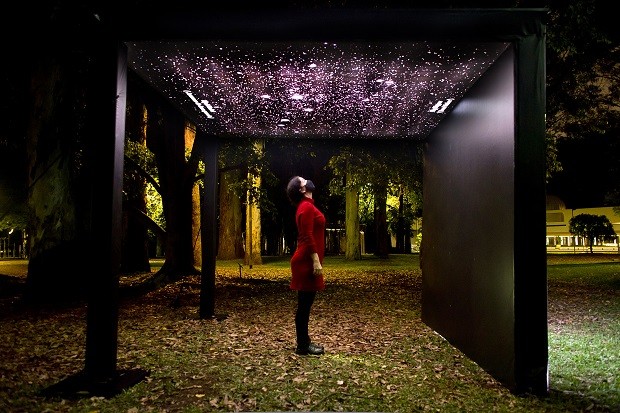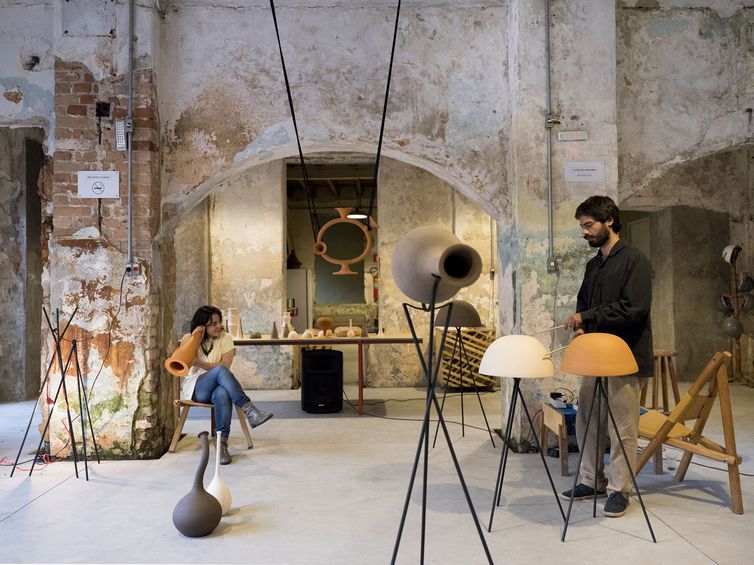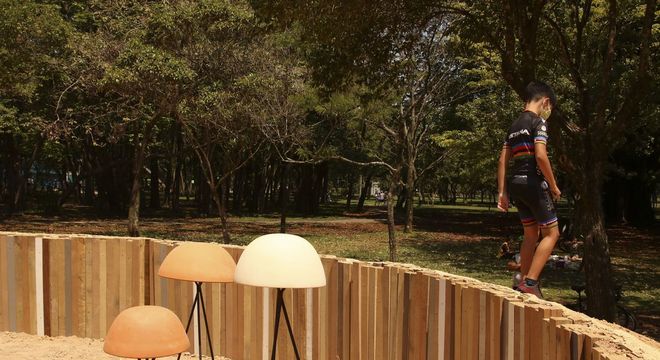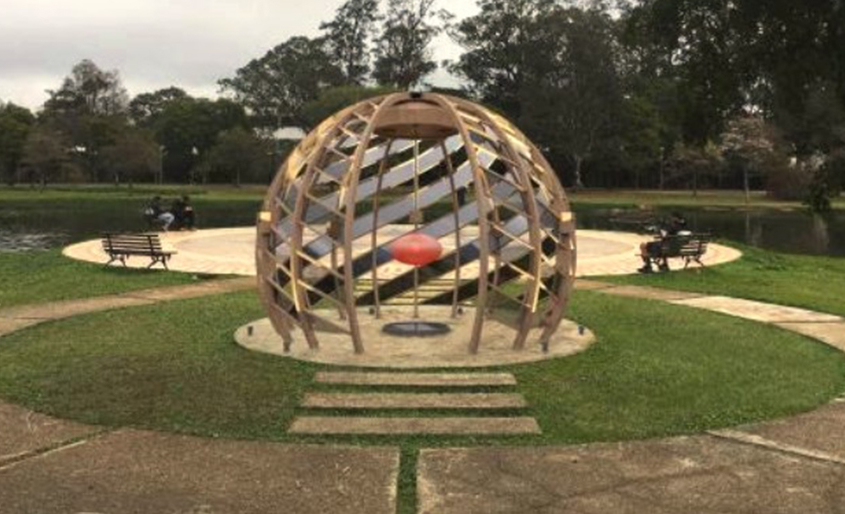RIO DE JANEIRO, BRAZIL – One of the most important public venues in the city of São Paulo, Ibirapuera Park has chosen a middle path during the pandemic. The 3M Art Show selected four artists through a public bid and six invited guests. Together, they will occupy the park and encourage reflections on the relationship between the individual and the collectivity in society.

For the first time in its history, the park will receive ten installations for the extension of the green area, fully outdoors. The event began on Saturday, November 7th and runs until December 6th, curated by Camila Bechelany – also a researcher and editor, with a focus on art and politics.
With the topic ‘Lugar Comum’ (Common Place): journeys and collectivities in the city, the concept developed for the exhibition explores the relationship of each individual as an active and receptive participant in the urban environment. The curator’s proposal reflects that through private and collective experiences, the individual plays the role of a transforming agent of public space.
Curator Camila Bechelany invited the artist and curator Camilla Rocha Campos and curator Eva González-Sancho Bodero to create a jury that discussed and selected the proposals enrolled in the notice. Of the ten projects exhibited in the park, four were selected through this call for bids. This year, the event received 338 installation proposals – 222 more than last year.
The artists selected were Maré de Matos (SP), Narciso Rosário (PI), Coletivo Foi à Feira (SP and ES) and the duo Gabriel Scapinelli and Otávio Monteiro (SP). The exhibition guests are Camila Sposati (SP), Cinthia Marcelle (MG), Diran Castro (SP), Lenora de Barros (SP), Luiza Crosman (RJ) and Rafael RG (SP).
Works adapted to the pandemic world
After the pandemic outbreak and its limitations, both the works and the show were entirely rethought, said the curator. “We had moments of many reflections during the process, we had many doubts about what it would be like to work on an editing and opening an exhibition during a health crisis, and it was necessary to reassess each of the works until reaching the ideal format, which would take into account the safety of the artists and the public, in addition to rethinking the projects conceptually so that they would make sense in a pandemic world.”

The public that enjoys interacting with the works and taking pictures alongside the installations have ensured the moment, said Camila. “The works have been adapted to welcome the public at a time when social distancing is the rule. We are complying with all the safety protocols to prevent contagion. All the works are installed in the park’s open areas and interaction will certainly be possible and safe. Taking photos of the works is both allowed and advisable.”
In addition to being one of the only visual arts projects to take place in the city, this year’s show is even more special, says Fernanda Del Guerra, director of Elo 3, the event’s creator and director.
“One of the longest running visual arts projects on the Brazilian scene, in which we have had the participation of important curators and artists, the 10th 3M Art Exhibition is a moment of celebration and thanks to all those involved, mainly the public, who have been with us for a decade, and to 3M, a patron committed to Brazilian arts and culture.”
Asked about the show’s similarity with the Inhotim Institute’s installations, Camila said that only the relationship of the works with nature is similar.
“The Inhotim Institute is an open air museum and botanical garden. The 10th 3M Art Exhibition was conceived from the start as an opportunity to think about art and public space. Ibirapuera Park was the venue in the city of São Paulo that was able to host this project and was chosen because it is a space of public access and has a symbolic history within the city’s context. It combines urban design with access to art and nature. The exhibition was not inspired by the Inhotim and can only be compared to the museum of Minas Gerais in terms of its relationship of artistic works with the green landscape,” she concluded.
The artists and their works
Selected through public notice, the Coletivo Foi à Feira – currently composed of Clarissa Ximenes, Gabriel Tye Luís Filipe Pôrto, Matheus Romanelli and Rayza Mucunã – presents the project Objeto Horizonte. Reconsidered and later transferred to the pandemic context, the installation is based on the archaeology of memory.
The work is a sphere, reflexive inside and transparent outside. Dedicated to being a space of self-reflection and an invitation for the visitor-participant to leave their wishes for a city of the future, the immersive experience features an LCD panel with the messages left and sounds with futuristic aesthetics. Visitors can leave audio recordings that will be sent to a receiver that converts the voices into random insertions of sounds, from an operating system, and the result will be like listening to a journey through time. “The concept was of a ‘spaceship’, a time capsule that could keep memories for several years,” says Clarissa Ximenes, one of the members of the collective formed in 2010.

Rafael RG presents two works: ‘O Brilho da Liberdade Diante dos Seus Olhos’ (The Glow of Freedom Before Your Eyes) and ‘Alto Astral’ (Upbeat). The first – ‘O Brilho da Liberdade Diante dos Seus Olhos’ is inspired by the biography of American abolitionist and activist Harriet Tubman – a black woman who fought for the end of slavery in the U.S.A. and made her escape route based on observation of the North Star constellation. The creation will be an outdoor installation with backlight.
At the Ibirapuera Planetarium the artist exhibits ‘Alto Astral’, a sound intervention, which relies on the involvement of astrologers who conduct astrological readings while visitors observe the original projection. The astrologers invited by RG also make a parallel with Tubman’s history and work with the astrology of native peoples and afro-diasporic cultures.
It will also be possible to observe the sky and experience Lenora de Barros’ work ‘O Que ouvir’ (What to listen to). Through a drone flying over the park area behind the Ibirapuera Auditorium designed by Oscar Niemeyer, with no camera, but with a powerful speaker, sounds are emitted from messages-poems recorded by the artist herself about the present time. Part of the risk group in this pandemic, Lenora remains in quarantine, recording a string of passages with different tones of voice and reorganizing ideas about the isolation period. According to her: “In the end, my idea is very symbolic to me. As an artist, I will join the show through my voice, regardless of following the isolation until the inauguration,” she reports. Five other speakers are arranged in the park to broadcast Lenora’s message, which talks mainly about surveillance and control (in a direct relationship with the feelings that isolation has brought us) with the idea of generating unexpected interventions to visitors in different spaces.
Through the equation “[earth> brick = oven] + flour x bread”, which represents the relationship between man and the production of bread, food that has been present for thousands of years in the life of human beings, the duo Gabriel Scapinelli and Otávio Monteiro conducted a participatory project to understand the collaborative processes involved in the art of making bread. The work, as well as being physically located throughout the park’s walkways, will also be held in House 1 – a welcoming center for the LGBTQIA+ community of São Paulo.
Within the project is the implementation of a bakery from the construction of a traditional oven and the organization of a number of workshops for learning the art of making bread. Visitors will be able to participate and understand, through experience, the meaning of producing their own food and the relationships that are articulated behind the action, which carries the meaning of autonomy, evolution and collectivity. The bakery should be an extension of the work, which does not finish with the end of the exhibition and intends to be the start of a creative economy.

Still within our relationship with food, the work of Narciso Rosário, ‘Canteiro Suspenso’ (Supended Flowrbed), inspired by his personal trajectory and affective memory, raises a discussion of how citizens relate to food production, addressing sustainability and ancestry issues through knowledge and planting practices. The project consists of a circular installation with 11 beds with varieties of edible and medicinal plants, allowing the public to have contact with the plants. In parallel, the artist organizes workshops and mediation initiativeson the show to discuss issues such as domestic cultivation and the possibilities of healing by plants.
Among ‘Mundo e Eu/A Caminho de Casa’ (The World and I/On My Way Home) is the work of Diran Castro that aims to draw the public’s attention to the gentrification process of Ibirapuera Park and the city of São Paulo. The artist seeks to rescue the memory of the place, which was erased throughout a historical silencing process. To do so, she will build a miniature city with a self-sustaining structure, which will have a path to follow, creating a space for reflection on what existed in the place before it became a park. This work is an invitation to aesthetic disobedience through installation, which will allow each individual to have their own understanding of the work.
The work of Camila Sposati, ‘Teatro Parque Arqueológico’ (Archaeological Park Theater), returns to her roots and seeks to connect with the local ancestry, it will also feature sound and performance interventions. The artist says: “My work is done in layers. The proposal is to look within the land”. In this work, Camila will build a representation of the old anatomic theater that will house her ceramic instruments-sculptures produced based on the Phonosophia series of works. The result will be an extremely unusual, surprising and vibrant environment in the park. The installation reflects on the passage of time: an induction to the observation of the past and an understanding of the tensions of the future. The performance sessions take place on Sundays, from November 8th to December 6th, from 1 PM to 6 PM.
Cinthia Marcelle re-reads ‘Geografia’ (Geography) [Unus Mundus series], a work produced at the Pampulha Museum in 2004. Guided by the commonplace topic, the artist has produced an installation with two paths: the one that addresses privilege and the one that addresses the periphery. From simple geometric progression, but on a large scale, arms of garden hoses join a watercourse leading to a tap, repeating themselves in a constant and “infinite” progression (since its end is not disclosed). An indication of actions that are constantly repeated in nature and in a one-on-one relationship, shaping the geography of the site. By reversing the “natural” sense of the water channeled from the tap to the lake, the artist invites to reflect that the water is always in motion and also to realize that a tap is not something as trivial as it seems. “Piped water is one of the main achievements of modern civilization and it implies decisively in how the control over natural resources and the consequent management of these ‘universal’ resources helps the city’s organization,” says the curator Camila Bechelany about the work.
The future, the land, the soil, the time. Recurring topics in the discussion about life in collectivity, enhanced by the works, gain another boost through ‘O Mundo versus o Planeta’ (The World versus the Planet), a project by Luiza Crossman. With three strands, the artist proposes the understanding about the differentiation of “Earth” and “planet” and about the relationship between art and science. With the intention of having not only the installation aspect, but also the curricular and collaborative one, Luiza rescues the idea of human scale and the experience of the world from the physical experience in the park, more specifically in the old sawmill. The educational curriculum (structure available so that this information about comparison and reflections can be institutionalized) occurs during the exhibition and in cooperation with two researchers. The third line of work is the online availability of knowledge on the subject from the continuation of the Trama Collection, a partnership with Zazie Edições to translate foreign authors and update the Brazilian editorial bibliography.
Maré de Matos discusses the collectivity through a space built to celebrate the differences in society, in the Public pulpit. As a pulpit built with three stairs and four megaphones allowing several accesses to the open megaphones. The installation addresses coexistence and a common point possible for all, regardless of the paths chosen since all the stairs lead to the same place: a space where everyone has a voice.
10th 3M Art Exhibition
Topic: “Lugar Comum: travessias e coletividades na cidade” (Common Place: Journeys and Collectivities in the City).
Date: November 7th to December 6th
3M Art Exhibition’s educational schedule: 10 AM to 9 PM
Venue: Ibirapuera Park – Pedro Álvares Cabral Avenue
Free entrance
Source: Agência Brasil

